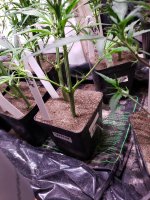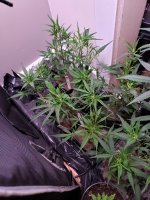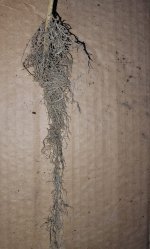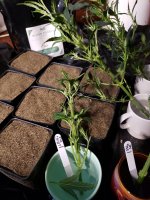TrulyAmazingGenetics
Active member
I think cloning in sand is a fun experiment for anyone regardless of experience level.
Sand could be the key for a struggling beginner to get on their way to building a library of mothers
No humidity dome or rooting hormones needed
No ph pen or ph products needed
Possible with low light levels
you can put the clones in your kitchen, bathroom, windowsill, in the shade under a tree when its summer.
No heat matt required
I've seen plants root in very low temps in sand might take longer with lower temps.
The places you can clone with this method are almost limitless. High Wind and extra low humidity can be problematic.
It doesn't get more natural if your growing in organic living soil.
Brush or wash the sand off the roots and reuse it. This way you wont change your soil type by adding sand with every clone. Its cheap and long lasting
Its the easiest most fail proof method I know. The only downside is that it is a little bit slower than rockwool or peat cubes.
Even if your system is perfect and you pump out rooted clones every 5 days you might not be impressed with a 2-3 week rooting period.
However, even for the cloning pro I would recommend this method as a way to reset moms and make sure they don't skip a beat from generation to generation.
In sand its possible to even root woody cuttings that are 18inches tall maybe even 2ft or more I don't know the limits but ive cut some huge clones to experiment and the resulting vigor of root growth and branching makes them feel like seed stock again.
Your moms will not get tired and dwarfed if you take large clones and root them in sand when you reset.
Overall I give sand a 7 out of 10 and its my go to for lazy man cloning. Just grab my scissors and cup of sand. Put it anywhere in my house with light. Keep watered for 2-3 weeks and ive got a new plant.
Methodology
For best results use cuttings that are a minimum 5 inches and 4 nodes. I like to do 7 inches of plant material down to where the stem is thicker and starting to get hardened off. This will stab into the sand better. For small soft thin stem type cuttings you will need to put them in while the sand is dry and then water them in or stick them in as you water for the first time. After watering the sand settles and can bend the stem of a small cutting.
I scrape the sides of the stem and make a diagonal cut at the base of the stem. I put them a couple inches down into the sand so im not really worried about where the cut is made I just care about over all size and thickness of the cutting.
Keep them moist until rooted. Its easier to knock the sand off when you let it dry down for a couple days before transplanting but it can be washed off aswell.
Ive rooted them of all sizes and areas of the plant.
Vigorous tops and higher branches will produce the strongest plants in veg allowing you to move into flowering stage faster than if you had done small cuttings
Its hard to overwater but they do not need much. I usually give them a light spray down with the pump sprayer even 24-48 hrs to keep the top layer of sand from drying out.
Even if you dry them out from time to time and forget about them they usually still root. If they get bone dry your in trouble ive had them wilt and come back before so keep trying.
I hope this helps someone or gives you a fun experiment to try out.
Much love
Have an AMAZING day
Sand could be the key for a struggling beginner to get on their way to building a library of mothers
No humidity dome or rooting hormones needed
No ph pen or ph products needed
Possible with low light levels
you can put the clones in your kitchen, bathroom, windowsill, in the shade under a tree when its summer.
No heat matt required
I've seen plants root in very low temps in sand might take longer with lower temps.
The places you can clone with this method are almost limitless. High Wind and extra low humidity can be problematic.
It doesn't get more natural if your growing in organic living soil.
Brush or wash the sand off the roots and reuse it. This way you wont change your soil type by adding sand with every clone. Its cheap and long lasting
Its the easiest most fail proof method I know. The only downside is that it is a little bit slower than rockwool or peat cubes.
Even if your system is perfect and you pump out rooted clones every 5 days you might not be impressed with a 2-3 week rooting period.
However, even for the cloning pro I would recommend this method as a way to reset moms and make sure they don't skip a beat from generation to generation.
In sand its possible to even root woody cuttings that are 18inches tall maybe even 2ft or more I don't know the limits but ive cut some huge clones to experiment and the resulting vigor of root growth and branching makes them feel like seed stock again.
Your moms will not get tired and dwarfed if you take large clones and root them in sand when you reset.
Overall I give sand a 7 out of 10 and its my go to for lazy man cloning. Just grab my scissors and cup of sand. Put it anywhere in my house with light. Keep watered for 2-3 weeks and ive got a new plant.
Methodology
For best results use cuttings that are a minimum 5 inches and 4 nodes. I like to do 7 inches of plant material down to where the stem is thicker and starting to get hardened off. This will stab into the sand better. For small soft thin stem type cuttings you will need to put them in while the sand is dry and then water them in or stick them in as you water for the first time. After watering the sand settles and can bend the stem of a small cutting.
I scrape the sides of the stem and make a diagonal cut at the base of the stem. I put them a couple inches down into the sand so im not really worried about where the cut is made I just care about over all size and thickness of the cutting.
Keep them moist until rooted. Its easier to knock the sand off when you let it dry down for a couple days before transplanting but it can be washed off aswell.
Ive rooted them of all sizes and areas of the plant.
Vigorous tops and higher branches will produce the strongest plants in veg allowing you to move into flowering stage faster than if you had done small cuttings
Its hard to overwater but they do not need much. I usually give them a light spray down with the pump sprayer even 24-48 hrs to keep the top layer of sand from drying out.
Even if you dry them out from time to time and forget about them they usually still root. If they get bone dry your in trouble ive had them wilt and come back before so keep trying.
I hope this helps someone or gives you a fun experiment to try out.
Much love
Have an AMAZING day






